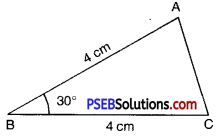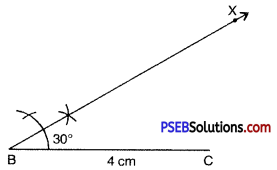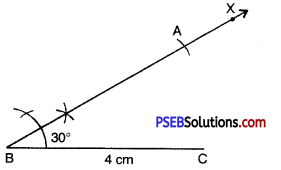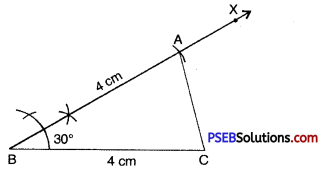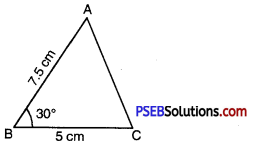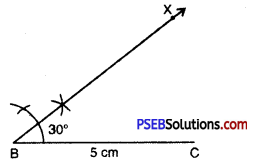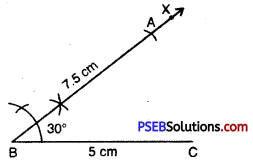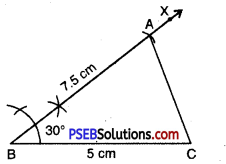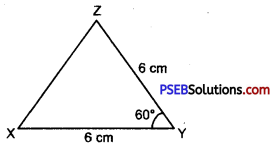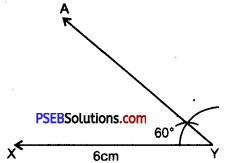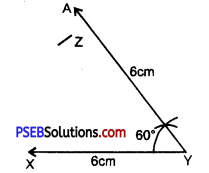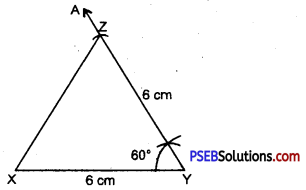Punjab State Board PSEB 7th Class English Book Solutions English Grammar Parts of Speech Exercise Questions and Answers, Notes.
PSEB 7th Class English Grammar Parts of Speech
शब्दों को प्रयोग के अनुसार आठ भागों अथवा श्रेणियों में विभाजित किया जाता है, जिन्हें Parts of Speech (शब्द भेद) कहते हैं। ये आठ भाग हैं-
- Noun
- Pronoun
- Adjective
- Verb
- Adverb
- Preposition
- Conjunction
- Interjection.
1. Noun-किसी व्यक्ति, स्थान, वस्तु अथवा गुण-दोष के नाम को Noun (संज्ञा) कहते हैं; जैसे Ram, Shyam, Mumbai, Pen, Pencil, Rose, Dog, Beauty, Honesty आदि।
![]()
2. Pronoun-जो शब्द किसी संज्ञा के स्थान पर प्रयोग होता है, उसे Pronoun (सर्वनाम) कहते हैं; जैसे I, we, you, they, he, she, it आदि।
3. Adjective-जो शब्द किसी Noun अथवा Pronoun की विशेषता प्रकट करता है, उसे Adjective (विशेषण) कहते हैं; जैसे good, bad, thin, fat, tall, many, useful आदि।
4. Verb-वह शब्द जिससे कार्य का होना अथवा करना प्रकट हो या जो शब्द किसी व्यक्ति, स्थान अथवा वस्तु के बारे में कुछ बतलाए, वह,शब्द Verb (क्रिया) कहलाता है; जैसे-
- The girl reads a book.
- Ram is a good boy.
- Mohan goes to school daily.
- Seema feels sad.
- I helped the poor.
5. Adverb जो शब्द किसी Verb, Adjective अथवा किसी अन्य Adverb की विशेषता प्रकट करे, तो उसे Adverb (क्रिया विशेषण) कहते हैं; जैसे-
- He ran fast. (Verb की विशेषता)
- Rose is very beautiful. (Adjective की विशेषता)
- He works too slowly. (Adverb की विशेषता)
6. Preposition-जो शब्द किसी Noun अथवा Pronoun से पहले प्रयोग किया जाता है और जो उनका सम्बन्ध वाक्य के अन्य शब्दों से जोड़ता है, उसे Preposition (सम्बन्धवाचक शब्द) कहते हैं; जैसे- .
- Mohan is at the gate.
- Ram is proud of his teacher.
- He is fond of music.
- I am writing with a pen.
7. Conjunction–जो शब्द, शब्दों अथवा वाक्यों को जोड़ता है, उसे Conjunction (संयोजक) कहते हैं; जैसे-
- Ram and Shyam are friends.
- You will get through if you work hard.
- He was late because he missed the bus.
- Either he or his brother is at fault.
8. Interjection-अकस्मात् भावना को व्यक्त करने वाला शब्द Interjection (विस्मयादिबोधक अव्यय) कहलाता है जैसे, Alas ! Hurrah ! Oh ! Lo! आदि।
Exercises
I. Write in the space provided the name of the part of speech to which the underlined words belong in the following sentences:
1. Seema is a beautiful girl.
2. Alas! His dog is dead.
3. The sun sets in the west.
4. The lion is a ferocious animal.
5. Delhi is a very big city.
6. Rahim is poor but honest.
7. Honesty is the best policy.
8. The.cat is under the table.
Hints:
1. Adjective
2. Interjection
3. Verb
4. Adjective
5. Adverb
6. Conjunction
7. Noun
8. Preposition.
II. Complete the following sentences with appropriate ‘Nouns’:
1. ……….. is a good boy.
2. She goes to the ……… everyday.
3. They go for a ……….. daily.
4. ……….. is the Capital of India.
5. ……… is the best policy.
6. The ………. rises in the …….
7. Chandigarh is the ……….. of Punjab and Haryana.
8. Shimla is a beautiful …………
Hints:
1. Mohan
2. temple/Gurudwara
3. walk
4. Delhi
5. Honesty
6. sun, east
7. capital
8. place.
III. Fill in the blanks with suitable “Pronouns’:
1. My son is playing with ……… toys.
2. ……….. father is working in Mumbai.
3. ……….. has gone abroad for higher studies.
4. This is ……… house.
5. The girls are doing ……….. homework.
6. ……….. is the bread-winner of the family.
7. We should respect ……. parents.
8. He loves ……… native place very much.
Hints:
1. his
2. My
3. He
4. our
5. their
6. She
7. our
8. his.
![]()
IV. Fill in the blanks with suitable ‘Adjectives’:
1. She is my ……….. friend.
2. Pudding is my ……….. dish.
3. The scenery of Mussoorie is
4. She likes to wear ……… dresses.
5. The Bible is a ……….. book.
6. Cricket is a ………. game.
7. John is an ……….. teacher.
8. Mango is a ………. fruit.
Hints:
1. best
2. favourite
3. beautiful
4. white
5. holy
6. good
7. English
8 juicy.
V. Fill in the blanks with suitable ‘Verbs’:
1. She ……….. ice-cream.
2. They ……….. a lot.
3. My mother ……….. food.
4. John …….. in a factory.
5. They ………. football.
6. We should ……….. a bath everyday.
7. The school peon ……….. the bell.
8. Seema ……….. for a walk daily.
Hints:
1. is eating
2. worked
3. cooks
4. works
5. play
6. take
7. rings
8. goes.
VI. Fill up the blanks with suitable ‘Adverbs’:
1. Sohan walks …………. .
2. Everyone should work ………..
3. She sings ………….
4. His dad is a …………. respectable man.
5. Our teacher speaks ……….. politely.
6. My sister sleeps …………
7. John is a ………. hardworking boy.
8. Girls sang …………. .
Hints:
1. slowly
2. hard
3. sweetly:
4. very
5. very
6. early
7. very
8. nicely.
VII. Complete the following sentences with suitable ‘Prepositions:
1. My grandfather is hard ……….. hearing.
2. My mom is fond ……… music.
3. A burglar broke ……….. our house last night.
4. The students should listen ………. their teachers attentively.
5. Yesterday we went ………. the Rose Garden.
6. Ayushi is playing ……….. the piano.
7. Children have been playing ……….. morning.
8. My uncle has been living ……….. Canada ……….. fifteen years.
9. I will play ……….. finishing my homework.
10. I am standing ……….. Anshu. Anshu is in front of me.
Hints:
1. of
2. of
3. into
4. to
5. to
6. on
7. since
8. in, for
9. after
10. behind.
![]()
VIII. Fill in the blanks with suitable ‘Conjunctions’:
1. My younger brother is both intelligent ……….. hardworking.
2. He says ………. he is a doctor.
3. ……….. Seema ………. Rita is at fault.
4. Our servant is poor ……….. honest.
5. He ………. his nephew manage the shop.
6. Ram went on leave ……….. he was injured.
7. You will get the tickets ………..you reach there before 6 o’clock.
8. ……….. he was late, yet he was able to catch the bus.
Hints:
1. and
2. that
3. Either, or
4. but
5. and
6. because
7. if
8. Although
IX. Fill in the blanks with suitable ‘Interjections’:
1. ……….. We have won the game.
2. ……. The man is dead.
3. ……… They have come.
V. Fill in the blanks with suitable ‘Verbs’:
1. She ……….. ice-cream.
2. They ……….. a lot.
3. My mother ……….. food.
4. John …….. in a factory.
5. They ………. football.
6. We should ……….. a bath everyday.
7. The school peon ……….. the bell.
8. Seema ……….. for a walk daily.
Hints:
1. is eating
2. worked
3. cooks
4. works
5. play
6. take
7. rings
8. goes.
VI. Fill up the blanks with suitable ‘Adverbs’:
1. Sohan walks …………. .
2. Everyone should work ………….
3. She sings …………..
4. His dad is a ………….. respectable man.
5. Our teacher speaks ……… politely.
6. My sister sleeps …………..
7. John is a …………. hardworking boy.
8. Girls sang ……….. .
Hints:
1. slowly
2. hard
3. sweetly
4. very
5. very
6. early
7. very
8. nicely.
VII. Complete the following sentences with suitable ‘Prepositions:
1. My grandfather is hard ……….. hearing.
2. My mom is fond ……… music.
3. A burglar broke ……….. our house last night.
4. The students should listen ………. their teachers attentively.
5. Yesterday we went ………. the Rose Garden.
6. Ayushi is playing ……….. the piano.
7. Children have been playing ……….. morning.
8. My uncle has been living ……….. Canada ……….. fifteen years.
9. I will play ……….. finishing my homework.
10. I am standing ……….. Anshu. Anshu is in front of me.
Hints:
1. of
2. of
3. into
4. to
5. to
6. on
7. since
8. in, for
9. after
10. behind.
VIII. Fill in the blanks with suitable ‘Conjunctions’:
1. My younger brother is both intelligent ……….. hardworking.
2. He says ………. he is a doctor.
3. ……….. Seema ………. Rita is at fault.
4. Our servant is poor ……….. honest.
5. He ………. his nephew manage the shop.
6. Ram went on leave ……….. he was injured.
7. You will get the tickets ………..you reach there before 6 o’clock.
8. ……….. he was late, yet he was able to catch the bus.
Hints:
1. and
2. that
3. Either, or
4. but
5. and
6. because
7. if
8. Although
![]()
IX. Fill in the blanks with suitable ‘Interjections’:
1. ……….. We have won the game.
2. ………… The man is dead.
3. …………. They have come.
4. …………. Is this the place?
5. …………. Well done.
6. ………….. He has lost all his money in gambling.
7. …………. You are hurt.
8. …………… He has failed again.
Hints:
1. Hurrah !
2. Alas!
3. Lo !
4. Oh !
5. Bravo !
6. Alas !
7. Oh !
8. Alas !
Exercise
Choose the correct option to determine which part of speech the underlined word belongs to:
Question 1.
Honesty is the best policy.
(a) noun
(b) verb
(c) adjective
(d) preposition
Answer:
(a) noun
Question 2.
The sun rises in the east.
(a) adjective
(b) verb
(c) noun
(d) preposition
Answer:
(c) noun
Question 3.
She is eating ice-cream.
(a) noun
(b) verb
(c) adjective
(d) preposition
Answer:
(b) verb
Question 4.
The school peon rings the bell.
(a) noun
(b) adjective
(c) verb
(d) preposition
Answer:
(c) verb
Question 5.
She likes to wear white dresses.
(a) noun
(b) verb
(c) adjective
(d) preposition
Answer:
(c) adjective
Question 6.
Mango is a juicy fruit.
(a) noun
(b) adjective
(c) verb
(d) preposition
Answer:
(b) adjective
Question 7.
My grandfather is hard of hearing.
(a) noun
(b) verb
(c) adjective
(d) preposition
Answer:
(d) preposition
Question 8.
Ayushi is playing on the piano.
(a) preposition
(b) verb
(c) adjective
(d) noun
Answer:
(a) preposition
Question 9.
My son is playing with his toys.
(a) pronoun
(b) adverb
(c) conjunction
(d) interjection
Answer:
(a) pronoun
![]()
Question 10.
We should respect our parents.
(a) adverb
(b) pronoun
(c) interjection
(d) conjunction
Answer:
(b) pronoun
Question 11.
Sohan walks slowly.
(a) pronoun
(b) adverb
(c) conjunction
(d) interjection
Answer:
(b) adverb
Question 12.
Our teacher speaks very politely.
(a) pronoun
(b) interjection
(c) conjunction
(d) adverb
Answer:
(d) adverb
Question 13.
He says that he is a doctor.
(a) pronoun
(b) adverb
(c) conjunction
(d) interjection
Answer:
(c) conjunction
Question 14.
Our servant is poor but honest.
(a) conjunction
(b) adverb
(c) pronoun
(d) interjection
Answer:
(a) conjunction
Question 15.
Hurrah ! We have won the match.
(a) pronoun
(b) adverb
(c) conjunction
(d) interjection
Answer:
(d) interjection
Question 16.
Alas ! He has failed again.
(a) pronoun
(b) interjection
(c) conjunction
(d) adverb
Answer:
(b) interjection
Name the part of speech of the bold words:
A. (i). He lives in a cottage.
(ii) Delhi is very big city.
B. (i) They go for a walk daily.
(ii) She is my best friend.
C. (i) Beauty does not last long.
(ii) The baby plays.
Fill in the blanks with an appropriate noun:
A. Shimla is a beautiful …………….
B. …………….. is the capital of India.
C. …………….. is a good boy.
Name the part of speech of the underlined words:
A. (i) Honesty is the best policy.
(ii) Pudding is my favourite dish.
B. (i) Dey is a good boy.
(ii) The girls are doing their homework.
C. (i) They play with the ball.
(ii) She sings sweetly.
![]()
Name the part of speech of the bold words:
A. (i) This is my house.
(ii) Our teacher speaks very politely.
B. (i) He lives in a cottage.
(ii) Josh is very handsome.
C. (i) The sun sets in the west.
(ii) Seema is a beautiful girl.
Choose the correct option to determine which part of speech the underlined word belongs to:
(i) Rohan is a handsome boy
(a) noun
(b) verb
(c) adjective
(d) preposition
Answer:
(c) adjective
(ü) Delhi is a big city.
(a) noun
(b) verb
(c) adjective
(d) preposition
Answer:
(a) noun

